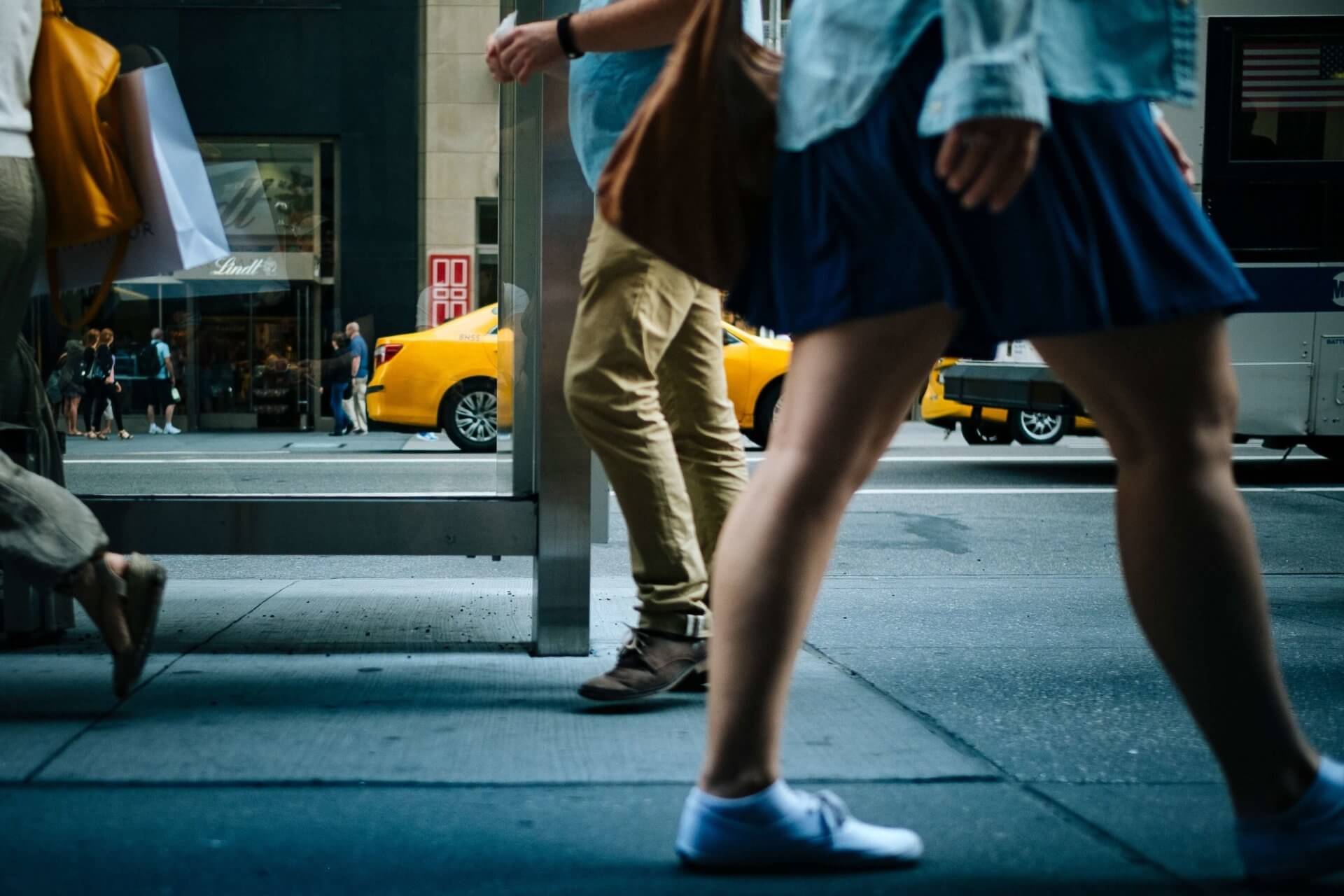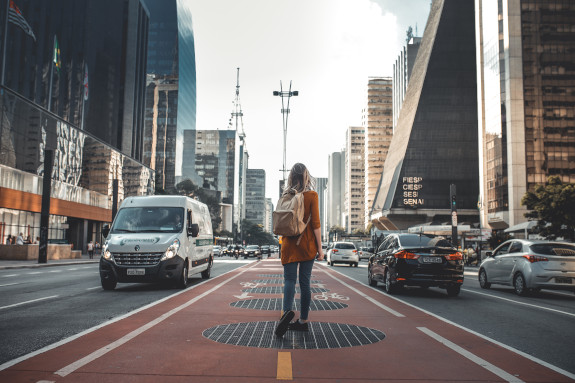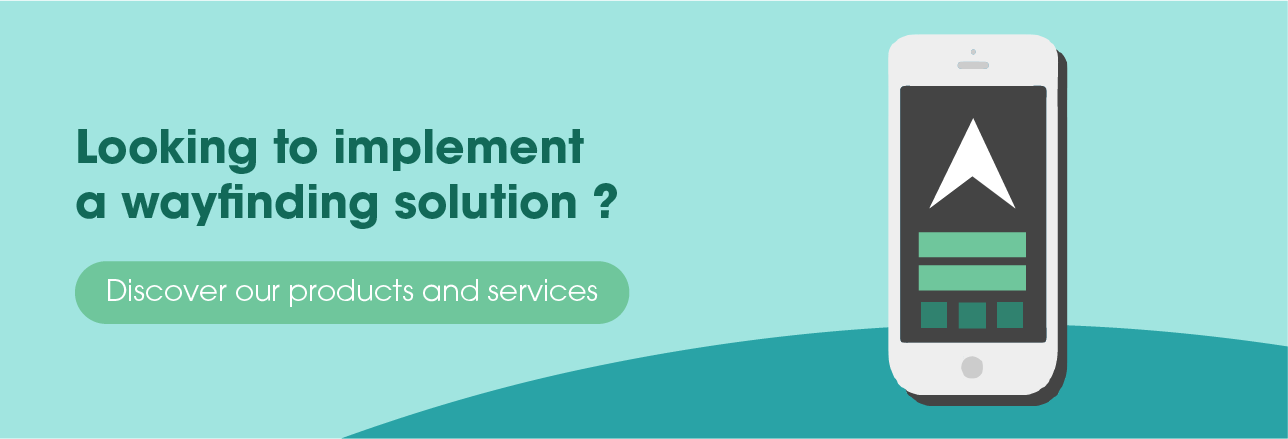
Ensuring urban mobility for all is a major challenge. Many people who are vulnerable because of their physical condition, mental health, age or strong cultural barriers can not move independently. The sidewalks that we walk every day without difficulty can be a source of anxiety and factor of social withdrawal for the most fragile people.
In the light of different surveys, we will try to understand the behavior and needs of fragile people in their travels. What are the difficulties encountered? What are the measures to be taken to improve their experience in the urban space? This article takes stock of the situation.
Make the city “legible”
According to Kevin Lynch’s book Image of the City (1960), the city is made “legible” thanks to five structuring elements: streets, neighborhoods, landmarks, boundaries and nodes (junction and concentration points). Pedestrians rely on these physical forms to find their bearings. They are meant to offer the user the opportunity to create a mental image of the places he or she walks.
When readability is lacking, apprehension takes the lead. This anxiety can become a real source of stress that paralyzes the most vulnerable people so that they give up moving and lose autonomy.
The perception of urban space varies from one user to another according to his physical and mental abilities, his personal experience and his culture. These personal filters encourage the consideration of the capacities of the most diverse users.
Priority goes therefore to the “legibility” of the city to improve the feeling of safety of all users.
Urban mobility: who are the most fragile people?
Disabled people
“About 15% of the world’s population lives with some form of disability, of whom 2-4% experience significant difficulties in functioning.” WHO
Disability typologies are grouped under six main categories:
⊗ mobility impairment
⊗ sensory disability
⊗ psychic handicap
⊗ mental disability
⊗ cognitive impairment
⊗ debilitating diseases
Among them, there are people with several disabilities of the same degree as deafblindness and people with a severe disability with multiple expressions resulting in extreme restriction of autonomy.
Old people
“Between 2015 and 2050, the proportion of the world’s population over 60 years old will nearly double from 12% to 22%.”(WHO)
The elderly are often affected by gait disorders, cognitive disorders and sensory disorders.
Foreigners
Cities around the world are not alike and that’s good! Culture is indeed at the heart of urban development. Some tourists and especially some immigrants can lose their bearings because of a different conception of the city as they know it and the lack of knowledge of the language. In American for exemple, over 76 million tourists from all over the world are visiting the country every year. In England, over 40 million visits have been recorded in 2017.
Other factors
Everyone can feel vulnerable, the time of a trip. Distraction, temporary tiredness or punctual stress are all factors that affect physical or intellectual abilities.
Movement strategies of the most vulnerable people
The Center for Studies and Expertise on Risks, the Environment, Mobility and Development (CEREMA) has initiated about twenty commented journeys in urban environments with so-called “fragile” people. The objective of this study is to highlight the difficulties of certain urban amenities and the travel choices of the most vulnerable people to solve these difficulties.
The perception of public space by people with disabilities
People with visual impairments face many technological and social challenges on a daily basis. But that’s without counting the environmental difficulties, especially in their movements in the city. The design of the public space is rather intended and thought for people who have all the senses. The experience of space without the eyes rests mainly on the decipherment of the sound and tactile cues, as for example:
⊗ attention to sidewalk changes that signal a zone change
⊗ listening to the noise of cars to appreciate the proximity of the street
⊗ the attention paid to the arrangement of the trees to know the position of the buildings, etc.
To move safely, visually impaired people make travel choices that vary from person to person such as:
⊗ be accompanied by a person
⊗ favor the streets at right angles and with few shops or terraces to avoid obstacles and crowds
⊗ walk along the walls to cross wide open spaces,
⊗ follow the GPS directions by choosing the shortest route or the one with the least turns
Deaf people, who have invisible disabilities, also find it difficult to decipher their environment. A study conducted by the Gare de Lyon in Paris shows that among users with all types of disabilities, it is the people with hearing problems who have the most difficulty to achieve a journey. This result can be explained by “the natural invisibility of hearing loss that does not generate spontaneous assistance from the public or staff (…) but also by the reluctance of the people involved to announce their disability”, says the study.
To decipher their environment, deaf people favor visual ambiances, kinesthetic or olfactory cues and breaks in the atmosphere or certain urban furniture. They rely mainly on written inscriptions, characteristic smells and break points.
In terms of choice of travel, the CEREMA study shows that deaf people generally avoid approaching areas considered dangerous as water bodies.
As for people with reduced mobility, they prefer a route adapted to their physical condition. Wheelchair users need alternatives to stairs, steps and slopes equal or greater than 1:12. In either case, they take care to prepare their trip upstream.
For people with mental, cognitive and psychic disabilities the understanding of the urban space is often altered by the worry and stress of the unknown. The disability can be aggravated when the logic of the organization of space is not made explicit. In this case, the person tends to give up moving. Travel choices focus on familiar routes, close to home and leave no room for the unexpected.
Public space for the elderly
Older people may also have sensory, physical or motor disabilities, or many at the same time. They are subject to stress, fatigue, memory loss. It can be difficult for them to read road signs or a map because of vision problems.
According to a March 2016 Observatory Mobility (OMNIL) survey, the main reason for moving for people over the age of 60 is the home-purchase journey.
Older people concentrate their trips to do their shopping near their homes. They will take their time, sit on public benches to rest, go outside of the period of influence…
The case of foreigners
For some foreigners, the city they discover may not have the architectural codes they know. In addition, the lack of knowledge of the language is an impediment to decipher road signs and ask for directions.
Preferred travel strategies are the use of a GPS or a map (which can be a distraction
and can cause accidents) and the assistance of passers-by.
Suggested improvements to enhance urban mobility of fragile people
Facilitating access to the city by all means designing more ergonomic urban spaces. Urban planners and public decision-makers must take into account the mobility difficulties of the entire population and set benchmarks to facilitate their orientation and their choice of trips.
Here are some ways to improve urban mobility for all:
⊗ Provide GPS-type tools for people with disabilities to calculate a route based on a specific disability
⊗ Design clear and visible signage by all to avoid endangerment by looking for clues
⊗ Install audio beacons in key city locations and transportation networks to guide visually impaired
⊗ Securing pedestrian crossings for the visually impaired by installing
⊗ Accessible Pedestrian Signals Avoid the creation of obstacles on the main axes of movement which are the reference routes for the most fragile users
⊗ Consult the users to seek feedbacks and the experts in order to propose adequate solutions
⊗ Make available and maintain accessibility equipment and street furniture, especially benches to rest and promote social bonds
⊗ Delimit space changes with clear visual or tactile cues
⊗ Limit spaces to a proper function to promote readability
⊗ Focus on the quality of public spaces ambiances to make them reassuring and welcoming
We are all vulnerable pedestrians. Tourist, expatriate, permanently or temporary disabled, subject to the tiredness of age or a busy day. This fragility, whatever its nature, induces a loss of autonomy and serenity in our travels.
A more legible city is a city that welcomes more visitors, boosts its economy and takes into account the travel choices of the entire population. Designing the city for the benefit of the most vulnerable means ensuring comfort and security for all. So consult the users and ask them about the areas to focus on to improve your city.
Start now to enhance urban mobility!
Check out our articles on the city of tomorrow:
MaaS: a Solution for Tomorrow’s Mobility
Disability as an Innovation Driver for the Smart City
media

Some tourists and especially some immigrants can lose their bearings because of a different conception of the city as they know it and the lack of knowledge of the language.
writer

Zoe Gervais
Content Manager
stay updated
Get the latest news about accessibility and the Smart City.
other articles for you

Open Data Is Key to Fostering Universal Accessibility
Open data represents an opportunity for cities to reach universal accessibility. It shows the missing links of the mobility chain.
Our Audio Beacons Guide the Blind and Visually Impaired at the Helsinki Subway
The Helsinky subway improved their audio signage system by installing on demand and remotely activated audio beacons.
7 Good Reasons to Install Audio Beacons at Your Public Transport Network
Audio beacons are an efficient way to provide more autonomy to blind and visually impaired people. They can easily use public transport.

Will Remote Activation Become the Norm for Accessible Pedestrian Signals?
More and more cities like New York have been exploring remote activation to trigger accessible pedestrian signals.
share our article!
more articles

Disability Statistics in the US: Looking Beyond Figures for an Accessible and Inclusive Society
Disability Statistics in the US: Looking Beyond Figures for an Accessible and Inclusive Society Around 61 million adults in the United States live with a disability. Diving into disability statistics in the US will help us know exactly who is concerned and what...
Our Audio Beacons Guide the Blind and Visually Impaired at the Helsinki Subway
Our Audio Beacons Guide the Blind and Visually Impaired at the Helsinki SubwayOur audio beacons equip the new line of the Helsinki subway in Finland. They help blind and visually impaired people locate the points of interest of a station. For users with visual...

Will Remote Activation Become the Norm for Accessible Pedestrian Signals?
Will Remote Activation Become the Norm for Accessible Pedestrian Signals?Without pushbutton, there are no accessible pedestrian signals. That’s how APS work in the U.S. But more and more cities have been exploring remote activation like New York City. The Department...

Hearing Impaired People: a Multitude of Profiles for Different Needs
Hearing Impaired People: a Multitude of Profiles for Different Needs Did you know that hearing impaired people have several profiles and that the way they identify themselves is important? You may be familiar with deaf and hard of hearing people but for each of...
NEVER miss the latest news about the Smart City.
Sign up now for our newsletter.
Unsubscribe in one click. The information collected is confidential and kept safe.
powered by okeenea
The French leading company
on the accessibility market.
For more than 25 years, we have been developing architectural access solutions for buildings and streets. Everyday, we rethink today’s cities to transform them in smart cities accessible to everyone.
By creating solutions ever more tailored to the needs of people with disabilities, we push the limits, constantly improve the urban life and make the cities more enjoyable for the growing majority.


